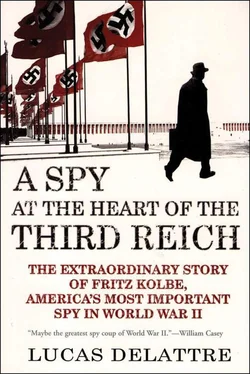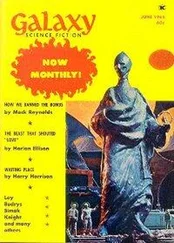Fritz helped the Americans to identify the fallback regions for all the advanced German industries: Thuringia and its deep underground shelters. Still in early July, Fritz gave the location of a factory where the first supersonic airplane in history was manufactured. He did not give its name, but it was the Messerschmitt 262. The factory was located in Kahla, in Thuringia: “near Orlamünde, between Rudolstadt and Jena. Factory in part underground. Already bombed in late June, but the damage is minimal, and the factory will soon enter the production phase.”
Fritz never forgot to speak of Berlin, where an American bombing raid on June 21, 1944 was particularly devastating:
The factory manufacturing diesel engines for submarines was destroyed. AEG is still operating in some of the factories of the city; the cable plant, however, is no longer running. The Hotel Continental and a block of houses around the hotel were destroyed by fire. The Friedrichstrasse railroad station was badly damaged and the Schlesischer railroad station was hit during the raid. The Osram factory was also hit but is still operating…. The Siemensstadt plant is almost at a standstill…. The AEG factory manufacturing precision instruments for submarines and the Knorr-Bremse plant, both of which are located at Treptower Park, were said to have been untouched.
Dulles was satisfied, as were his Washington colleagues. What they did not know was that Fritz Kolbe was also involved in seditious activities. The telegram from Fritz that was received on May 20 (“Please, no cigarettes”) had hinted that he was in danger. Sometime in the spring, he was supposed to go with Walter Bauer to a secret meeting in Potsdam with some civilian and military conspirators close to Count Waldersee. Because of an organizational error due to faulty internal communication, neither he nor Walter Bauer went to the meeting. Waldersee was also absent. This was lucky for them, because the list of people present at this secret meeting fell into the hands of the Gestapo. A few months later, all of them were to be executed.
Berlin, late July 1944
After the Allied landing in Normandy, the armies of the Reich carried out a vast defensive withdrawal, but they were still fighting. Was this the beginning of the end? The failed assassination attempt against Hitler on July 20, 1944 was enough to make the enemies of Nazism lose all hope. The only virtue of the plot, despite its failure, had been “that the German resistance movement [had taken] the plunge before the eyes of the world and of history.” For all those who dreamed of the fall of the regime, there seemed to be no way out but to turn in on themselves, to “love one’s country in silence and in silence scorn its leaders.” The most incredulous were obliged to agree that Hitler seemed to be protected by providence.
There was another miracle: Fritz Kolbe’s clandestine activities remained unnoticed. Fritz had even received a promotion in early July, rising from the rank of “consular secretary” to “secretary of the chancellery” ( Kanzler ). The party, as usual, had a right of veto over this promotion. The ministry had sent a four-page form to the regional headquarters of the NSDAP (Hermann-Göring-Strasse 14 in Berlin), a document in which it was stated that Fritz was not a member of the party but that he was “of German blood” and that he “worked tirelessly and well for the National Socialist state.” Even though four months had gone by before the party deigned to respond to the request, all the required stamps had been obtained and the ministry’s decision had been ratified. Fritz continued to give his best efforts to his work in order to be well judged by his superiors.
However, the climate of anxiety was constantly intensifying. Although not closely associated with any of the conspirators, Fritz felt directly concerned by the slaughter that struck the ranks of the resistance during those bloody weeks. Several members of the Foreign Ministry were soon arrested and sentenced to death. Ferdinand Sauerbruch was questioned by the Gestapo because he had been in regular contact with friends of Count Stauffenberg. “Sauerbruch thinks that we are lost, he and I. He may be right,” wrote Fritz in one of his messages to Bern. If someone like the professor himself was no longer safe, the worst was to be feared.
Adolphe Jung recounts how the surgeon saved his own skin:
After the failure of the assassination attempt, Sauerbruch lived in fear. He went to the country, to property owned by his wife, near Dresden, and spent about a week there. In fact, he was aware of what had been attempted, although he himself did not participate. After the fact, some allusions he had made before the attempt relating to “events of great importance soon about to happen” became meaningful for me. Five people in his immediate entourage and among his close friends had participated and were shot or hanged. In addition, one of Sauerbruch’s three sons, a career officer, who had reached the rank of lieutenant-colonel, was a close friend of Count von Stauffenberg. Soon thereafter, then, he was incarcerated and seriously interrogated for three weeks. Very worried, Sauerbruch called or wrote to friends and colleagues who were members of the party or the SS. Time was short. With his son in prison, things could have quickly turned nasty for him. In any event, his son would not have been released so quickly if Sauerbruch had not immediately gotten in touch with, among others, Max de Crinis, a professor of neurology, a friend of Hitler, and an important figure in the party, and with Professor Gebhardt, a military doctor with the rank of general in the army…. It was probably through their discreet and effective support that Sauerbruch was not imprisoned and could escape from the reprisals that followed the attempt.
Sauerbruch was spared, but many of his friends did not survive the repression of the summer of 1944. On July 12, the Wednesday Club met as though everything were normal, with a presentation by Werner Heisenberg on the history of astronomy. The session had concluded with a feast of fresh raspberries picked in the garden of the Kaiser-Wilhelm Physics Institute in Dahlem. This was the last meeting at which General Beck was present: He shot himself in the head on the evening of July 20, 1944 in Berlin. Johannes Popitz was arrested on July 21, Ulrich von Hassell on July 28. Their imminent execution was not in doubt. On July 26, the Wednesday Club convened for the last time. The meeting took place at the home of the journalist and critic Paul Fechter, who spoke about literature in a room that was three-quarters empty.
Bern, August 1944
The failure of the plot was a catastrophe for the Americans. Even though Allen Dulles mistrusted Count Stauffenberg, vaguely suspected of wanting to make a deal with the Soviets, the news of the fiasco filled him with bitterness and perplexity. “I never saw Dulles and Gaevernitz so downtrodden,” according to the Bavarian Social Democrat Wilhelm Hoegner, who met them in Bern shortly after the events of July 20. If Hitler had been assassinated, the war could have been brought to a rapid conclusion. In addition, this evil stroke of fate would probably facilitate the rise to power of the hardest elements in the Nazi regime. In a message to Washington dated August 8, 1944, Dulles wrote that “Himmler and the Gestapo took advantage of the Putsch to finish off the job.” Radicalization of the resistance was also predictable. On August 9, Dulles wrote: “The most efficiently organized body for work is now the Communist group.” As for the military situation, it was taking a turn dangerously favorable to Stalin. In mid-August 1944, the first Soviet soldiers reached the borders of the Reich in East Prussia. The Americans, for their part, were not yet in Paris.
Читать дальше











